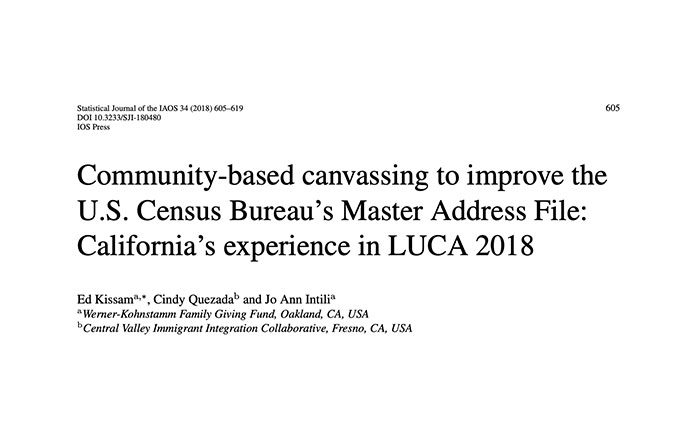Community-sourced data and use of technology by local governments has helped make the Local Update of Census Addresses (LUCA) a success in California. A recently-released study reviewing California’s Local Update of Census Addresses (LUCA) shows how canvassing by community-based organizations helped protect $455 million in federal funding that would otherwise have been lost in an undercount.
“A major cause of…census undercount in the United States is that ‘unconventional,’ often hidden, housing units where many low-income families — predominantly minorities and immigrants — live are left off the U.S. Census Bureau’s address list,” writes Ed Kissam, Cindy Quezada, and Jo Ann Initili in “Community-based canvassing to improve the U.S. Census Bureau’s Master Address File: California’s experience in LUCA 2018,” recently published in the Statistical Journal of the IAOS.
When a unit is omitted from the US Census Bureau’s Master Address File (MAF), the people living within it do not receive a self-response form and are likely to be missed by census enumerators. Kissam et al. estimate that up to one-half of census undercount can be attributed to omitted units.
Due to budget cuts, the Census Bureau is reducing the amount of in-field address verification it’s performing from 100% to 30% nationwide.
To make up for this decrease, cities and counties recruited local nonprofits to canvass their neighborhoods and focus on unconventional units — RV’s, converted garages, and back of the house add-ons — that are often omitted from the MAF. The study reported that the canvassing led to the successful identification and addition of 1.3% more housing units to the existing address list.
The Census Bureau instituted LUCA in 1998 as a means for local government to submit additions and revisions to its MAF prior to the decennial census. While local governments have historically relied on administrative records for additions, this research shows that in-field address canvassing performed by local, community-based organizations is a low-cost, effective means of identifying unconventional units that would not otherwise appear in such records.
State and local governments have a strong financial incentive for investing in robust canvassing efforts for LUCA because census outcomes directly impact how much federal funding their community receives. According to the study’s estimates, California was able to turn $7 million of funding for LUCA efforts into approximately $455 million in funding for the state.
California’s LUCA success is largely due to community-based organizations leveraging their familiarity with the area and community to canvass more effectively. In one urban county for instance, Kissam and his co-authors note that local canvassers “knew to walk along back alleys where the entrances to unconventional housing were more visible than at the front of properties.” Their targeted approach allowed the small, urban county to add nearly 500 addresses to the Census’ MAF, which translates to over $1,500,000 in federal funding.
“This paper highlights the value of equipping local people with technology that enables crowd-sourced data to be collected in an easy, organized and coordinated way,” says Perla Ni, CEO of CommunityConnect Labs.
CommunityConnect Labs partnered with some of the counties to conduct the LUCA community-based address canvassing. The custom LUCA canvassing tool allowed volunteers to upload unconventional units to a centralized hub via mobile message; those additions were then securely delivered to local governments.
For the future, Kissam and his co-authors recommend increased collaboration between the US Census Bureau, local governments and local nonprofits. With the help of innovative technology solutions, community-based organizations can ensure that their vulnerable populations are represented in censuses to come.
To read the full research article, visit this link

